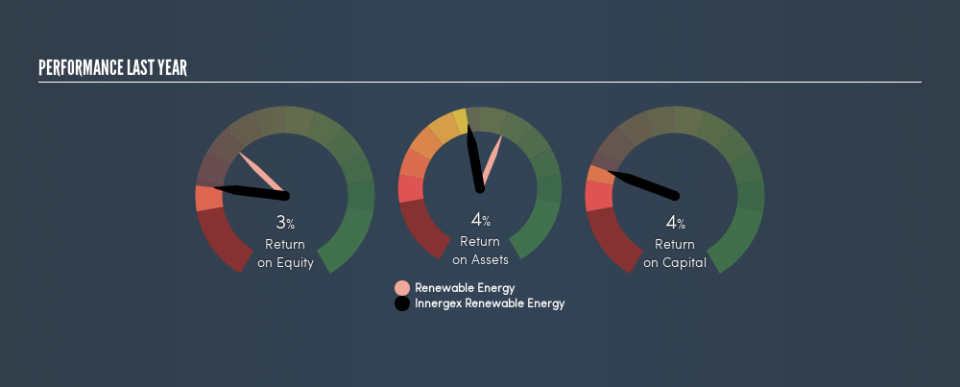Here’s What Innergex Renewable Energy Inc.’s (TSE:INE) Return On Capital Can Tell Us

Today we are going to look at Innergex Renewable Energy Inc. (TSE:INE) to see whether it might be an attractive investment prospect. In particular, we’ll consider its Return On Capital Employed (ROCE), as that can give us insight into how profitably the company is able to employ capital in its business.
Firstly, we’ll go over how we calculate ROCE. Second, we’ll look at its ROCE compared to similar companies. Finally, we’ll look at how its current liabilities affect its ROCE.
Return On Capital Employed (ROCE): What is it?
ROCE is a measure of a company’s yearly pre-tax profit (its return), relative to the capital employed in the business. All else being equal, a better business will have a higher ROCE. Ultimately, it is a useful but imperfect metric. Author Edwin Whiting says to be careful when comparing the ROCE of different businesses, since ‘No two businesses are exactly alike.’
How Do You Calculate Return On Capital Employed?
The formula for calculating the return on capital employed is:
Return on Capital Employed = Earnings Before Interest and Tax (EBIT) ÷ (Total Assets – Current Liabilities)
Or for Innergex Renewable Energy:
0.037 = CA$213m ÷ (CA$6.5b – CA$642m) (Based on the trailing twelve months to December 2018.)
So, Innergex Renewable Energy has an ROCE of 3.7%.
Check out our latest analysis for Innergex Renewable Energy
Does Innergex Renewable Energy Have A Good ROCE?
ROCE is commonly used for comparing the performance of similar businesses. It appears that Innergex Renewable Energy’s ROCE is fairly close to the Renewable Energy industry average of 4.2%. Putting aside Innergex Renewable Energy’s performance relative to its industry, its ROCE in absolute terms is poor – considering the risk of owning stocks compared to government bonds. Readers may wish to look for more rewarding investments.
It is important to remember that ROCE shows past performance, and is not necessarily predictive. Companies in cyclical industries can be difficult to understand using ROCE, as returns typically look high during boom times, and low during busts. ROCE is, after all, simply a snap shot of a single year. What happens in the future is pretty important for investors, so we have prepared a free report on analyst forecasts for Innergex Renewable Energy.
Do Innergex Renewable Energy’s Current Liabilities Skew Its ROCE?
Current liabilities include invoices, such as supplier payments, short-term debt, or a tax bill, that need to be paid within 12 months. The ROCE equation subtracts current liabilities from capital employed, so a company with a lot of current liabilities appears to have less capital employed, and a higher ROCE than otherwise. To counter this, investors can check if a company has high current liabilities relative to total assets.
Innergex Renewable Energy has total assets of CA$6.5b and current liabilities of CA$642m. Therefore its current liabilities are equivalent to approximately 9.9% of its total assets. With barely any current liabilities, there is minimal impact on Innergex Renewable Energy’s admittedly low ROCE.
What We Can Learn From Innergex Renewable Energy’s ROCE
Still, investors could probably find more attractive prospects with better performance out there. You might be able to find a better buy than Innergex Renewable Energy. If you want a selection of possible winners, check out this free list of interesting companies that trade on a P/E below 20 (but have proven they can grow earnings).
For those who like to find winning investments this free list of growing companies with recent insider purchasing, could be just the ticket.
We aim to bring you long-term focused research analysis driven by fundamental data. Note that our analysis may not factor in the latest price-sensitive company announcements or qualitative material.
If you spot an error that warrants correction, please contact the editor at editorial-team@simplywallst.com. This article by Simply Wall St is general in nature. It does not constitute a recommendation to buy or sell any stock, and does not take account of your objectives, or your financial situation. Simply Wall St has no position in the stocks mentioned. Thank you for reading.

 Yahoo Finance
Yahoo Finance 
